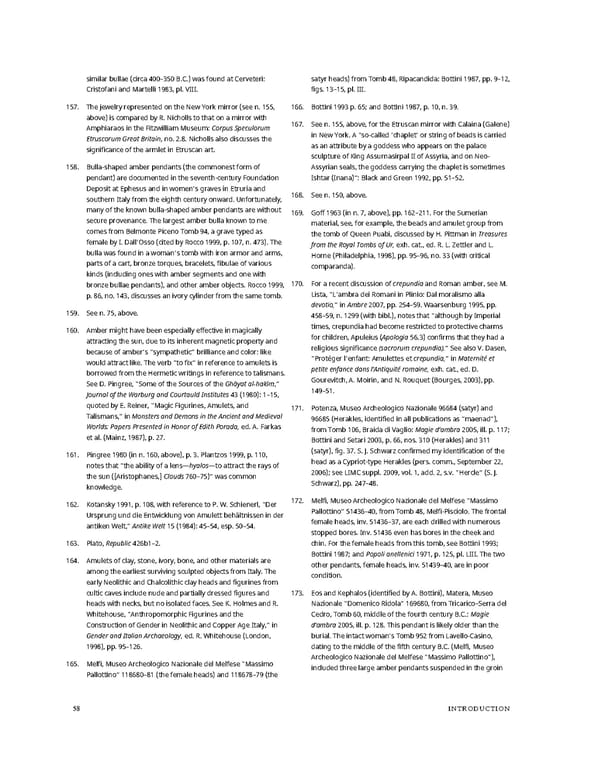similar bullae (circa 400–350 B.C.) was found at Cerveteri: satyr heads) from Tomb 48, Ripacandida: Bottini 1987, pp. 9–12, Cristofani and Martelli 1983, pl. VIII. figs. 13–15, pl. III. 157. The jewelry represented on the New York mirror (see n. 155, 166. Bottini 1993 p. 65; and Bottini 1987, p. 10, n. 39. above) is compared by R. Nicholls to that on a mirror with 167. Seen. 155, above, for the Etruscan mirror with Calaina (Galene) Amphiaraos in the Fitzwilliam Museum: Corpus Speculorum in New York. A “so-called ‘chaplet’ or string of beads is carried Etruscorum Great Britain, no. 2.8. Nicholls also discusses the as an attribute by a goddess who appears on the palace significance of the armlet in Etruscan art. sculpture of King Assurnasirpal II of Assyria, and on Neo- 158. Bulla-shaped amber pendants (the commonest form of Assyrian seals, the goddess carrying the chaplet is sometimes pendant) are documented in the seventh-century Foundation Ishtar (Inana)”: Black and Green 1992, pp. 51–52. Deposit at Ephesus and in women’s graves in Etruria and 168. Seen. 150, above. southern Italy from the eighth century onward. Unfortunately, many of the known bulla-shaped amber pendants are without 169. Goff 1963 (in n. 7, above), pp. 162–211. For the Sumerian secure provenance. The largest amber bulla known to me material, see, for example, the beads and amulet group from comes from Belmonte Piceno Tomb 94, a grave typed as the tomb of Queen Puabi, discussed by H. Pittman in Treasures female by I. Dall’Osso (cited by Rocco 1999, p. 107, n. 473). The from the Royal Tombs of Ur, exh. cat., ed. R. L. Zettler and L. bulla was found in a woman’s tomb with iron armor and arms, Horne (Philadelphia, 1998), pp. 95–96, no. 33 (with critical parts of a cart, bronze torques, bracelets, fibulae of various comparanda). kinds (including ones with amber segments and one with bronze bullae pendants), and other amber objects. Rocco 1999, 170. For a recent discussion of crepundia and Roman amber, see M. p. 86, no. 143, discusses an ivory cylinder from the same tomb. Lista, “L’ambra dei Romani in Plinio: Dal moralismo alla devotio,” in Ambre 2007, pp. 254–59. Waarsenburg 1995, pp. 159. Seen. 75, above. 458–59, n. 1299 (with bibl.), notes that “although by Imperial 160. Amber might have been especially effective in magically times, crepundia had become restricted to protective charms attracting the sun, due to its inherent magnetic property and for children, Apuleius (Apologia 56.3) confirms that they had a because of amber’s “sympathetic” brilliance and color: like religious significance (sacrorum crepundia).” See also V. Dasen, would attract like. The verb “to fix” in reference to amulets is “Protéger l’enfant: Amulettes et crepundia,” in Maternité et borrowed from the Hermetic writings in reference to talismans. petite enfance dans l’Antiquité romaine, exh. cat., ed. D. See D. Pingree, “Some of the Sources of the Ghāyat al-hakīm,” Gourevitch, A. Moirin, and N. Rouquet (Bourges, 2003), pp. Journal of the Warburg and Courtauld Institutes 43 (1980): 1–15, 149–51. quoted by E. Reiner, “Magic Figurines, Amulets, and 171. Potenza, Museo Archeologico Nazionale 96684 (satyr) and Talismans,” in Monsters and Demons in the Ancient and Medieval 96685 (Herakles, identified in all publications as “maenad”), Worlds: Papers Presented in Honor of Edith Porada, ed. A. Farkas from Tomb 106, Braida di Vaglio: Magie d’ambra 2005, ill. p. 117; et al. (Mainz, 1987), p. 27. Bottini and Setari 2003, p. 66, nos. 310 (Herakles) and 311 161. Pingree 1980 (in n. 160, above), p. 3. Plantzos 1999, p. 110, (satyr), fig. 37. S. J. Schwarz confirmed my identification of the notes that “the ability of a lens—hyalos—to attract the rays of head as a Cypriot-type Herakles (pers. comm., September 22, the sun ([Aristophanes,] Clouds 760–75)” was common 2006); see LIMC suppl. 2009, vol. 1, add. 2, s.v. “Hercle” (S. J. knowledge. Schwarz), pp. 247–48. 162. Kotansky 1991, p. 108, with reference to P. W. Schienerl, “Der 172. Melfi, Museo Archeologico Nazionale del Melfese “Massimo Ursprung und die Entwicklung von Amulett behältnissen in der Pallottino” 51436–40, from Tomb 48, Melfi-Pisciolo. The frontal antiken Welt,” Antike Welt 15 (1984): 45–54, esp. 50–54. female heads, inv. 51436–37, are each drilled with numerous stopped bores. Inv. 51436 even has bores in the cheek and 163. Plato, Republic 426b1–2. chin. For the female heads from this tomb, see Bottini 1993; 164. Amulets of clay, stone, ivory, bone, and other materials are Bottini 1987; and Popoli anellenici 1971, p. 125, pl. LIII. The two among the earliest surviving sculpted objects from Italy. The other pendants, female heads, inv. 51439–40, are in poor early Neolithic and Chalcolithic clay heads and figurines from condition. cultic caves include nude and partially dressed figures and 173. Eos and Kephalos (identified by A. Bottini), Matera, Museo heads with necks, but no isolated faces. See K. Holmes and R. Nazionale “Domenico Ridola” 169680, from Tricarico–Serra del Whitehouse, “Anthropomorphic Figurines and the Cedro, Tomb 60, middle of the fourth century B.C.: Magie Construction of Gender in Neolithic and Copper Age Italy,” in d’ambra2005, ill. p. 128. This pendant is likely older than the Gender and Italian Archaeology, ed. R. Whitehouse (London, burial. The intact woman’s Tomb 952 from Lavello-Casino, 1998), pp. 95–126. dating to the middle of the fifth century B.C. (Melfi, Museo 165. Melfi, Museo Archeologico Nazionale del Melfese “Massimo Archeologico Nazionale del Melfese “Massimo Pallottino”), Pallottino” 118680–81 (the female heads) and 118678–79 (the included three large amber pendants suspended in the groin 58 INTRODUCTION
 Ancient Carved Ambers in the J. Paul Getty Museum Page 67 Page 69
Ancient Carved Ambers in the J. Paul Getty Museum Page 67 Page 69